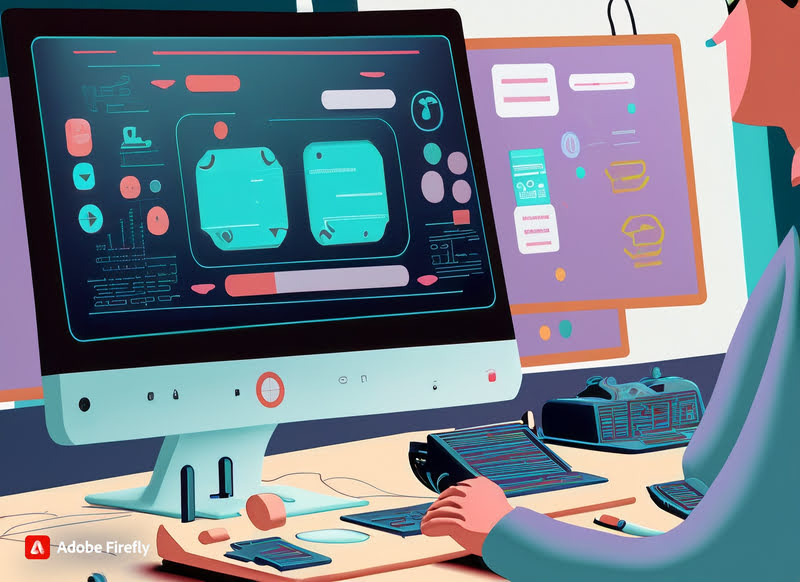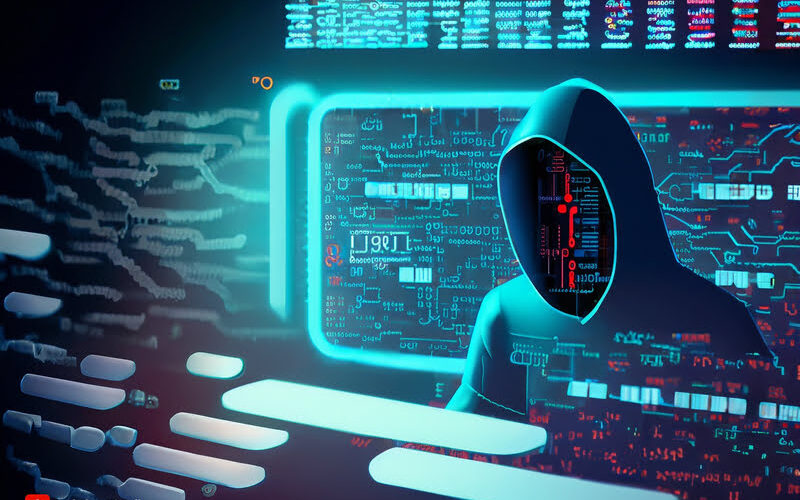In a world where the heartbeat of technology quickens with each passing day, UI/UX design emerges as the thrilling arena where businesses engage in an exhilarating duel for user engagement and satisfaction. This article embarks on a captivating journey to explore how the dynamic forces of AI and emerging technologies are reshaping the very essence of UX-UI design, unlocking a realm of uncharted possibilities and forging the destiny of digital experiences.
The Evolution of UI/UX Design
Before we plunge into the AI-driven revolution, let’s take a brief journey into the evolution of UI/UX design. Traditionally, UI/UX design relied heavily on the intuitive understanding of human behavior, ease of use, and visual appeal. Designers crafted interfaces and experiences based on their expertise, user feedback, and best practices.
However, the advent of AI and emerging technologies has introduced a seismic shift in this paradigm.
AI today plays a pivotal role across various stages of Design Thinking and the design process, spanning from ideation to product development. Whether it’s in User Research, Idea Generation, Rapid Prototyping, or User Testing, AI empowers Product teams to create world-class products with high adoption and engagement rates.
Now, let’s explore the top 5 ways AI is transforming the UI/UX design landscape.
- AI-Powered Data-Driven Design
AI has breathed life into data-driven design. It has endowed designers with the ability to harness vast troves of user data to inform design decisions. Take Netflix, for example. Their recommendation system, powered by AI algorithms, analyzes user preferences and viewing habits to suggest content tailored to individual tastes. This level of personalization enhances user satisfaction and retention, demonstrating the potential of AI in UI/UX design.
Moreover, AI can perform A/B testing at an unparalleled scale and speed, enabling designers to experiment with different design variations and instantly assess their impact on user behavior. Companies like Facebook employ AI to conduct thousands of A/B tests concurrently, optimizing their platform for user engagement.
- Conversational Interfaces and Chatbots
Conversational interfaces have witnessed a meteoric rise, with chatbots becoming ubiquitous across websites and applications. These chatbots are no longer rudimentary question-answer machines. They leverage natural language processing (NLP) and machine learning to provide seamless, human-like interactions.
Consider the chatbot on the website of a major airline. It assists users in booking flights, checking in, and even handling customer support inquiries. Through continuous learning from user interactions, these chatbots refine their responses and improve user experiences over time.
- Enhanced User Assistance and Support
AI-powered virtual assistants, such as Siri, Alexa, and Google Assistant, have become indispensable in our daily lives. In the UX-UI design realm, they offer new opportunities to enhance user assistance and support.
Imagine a healthcare app that employs AI to provide personalized health recommendations. It can analyze a user’s medical history, fitness data, and dietary preferences to offer tailored advice, thereby improving user engagement and promoting healthier lifestyles.
- Personalization at Scale
One of the most remarkable impacts of AI on UI/UX design is its ability to deliver hyper-personalization at scale. Amazon, for instance, leverages AI to analyze a user’s browsing and purchasing history, serving up product recommendations that are uncannily aligned with individual preferences.
Similarly, streaming platforms like Spotify use AI to curate playlists and recommend songs based on a user’s music taste. These personalized experiences not only boost user engagement but also drive revenue growth.
- Democratization of Design Tools
AI is not just a tool for designers; it’s also democratizing the design process itself. AI-powered design tools, such as Adobe’s Sensei and Runway ML, are making it easier for non-designers to create aesthetically pleasing and functional interfaces.
These tools offer features like automated layout suggestions, color palette recommendations, and even the generation of design elements based on textual descriptions. This empowers startups and small businesses to produce professional-grade UI/UX without the need for extensive design expertise.
Top 3 Trending Design AI Tools
1. Figma Dev Mode: Empowering Seamless Collaboration and Prototyping
In the ever-evolving landscape of UI/UX design, Figma Dev Mode stands as a beacon of innovation, reshaping how designers collaborate and prototype. With its intuitive interface and powerful AI-driven features, Figma Dev Mode streamlines the design process, enhancing efficiency and creativity.
Key Features:
- Real-time Collaboration: Enables seamless collaboration between designers, engineers, and stakeholders in real-time, fostering efficient teamwork.
- AI-Enhanced Prototyping: Integrates AI algorithms for intelligent ideation and prototyping, offering valuable suggestions based on user behavior data.
- Design-to-Development Integration: Facilitates a smooth transition from design to development by providing development-ready assets and elements.
- Intuitive Interface: User-friendly interface that simplifies complex design processes and encourages creativity.
- Data-Driven Design: Harnesses data-driven insights to inform design decisions, ensuring user-centric and informed design choices.
2. Uizard: Redefining Visual Design with AI-Powered Creativity
Uizard has emerged as a game-changer in the realm of visual design, offering designers a robust AI-driven platform to bring their creative visions to life.
Key Features:
- Visual Design Transformation: Transforms rough sketches and wireframes into polished, high-fidelity designs with remarkable accuracy.
- Design-to-Development Ready: Generates design elements that are both visually appealing and development-ready, bridging the gap between design and development teams.
- Rapid Prototyping: Accelerates the design iteration process by swiftly translating ideas into tangible prototypes.
- AI-Powered Interpretation: Interprets designer input effectively, understanding the nuances of creative vision and translating them into design elements.
- Streamlined Workflow: Enhances workflow efficiency, allowing designers to focus on creativity while reducing time spent on repetitive tasks.
3. Taskade: Elevating Product Elaboration and Collaboration
Taskade redefines the way UI/UX designers conceptualize and elaborate on their products, offering a collaborative platform powered by AI-driven insights.
Key Features:
- Intelligent Suggestions: Utilizes AI algorithms to provide intelligent suggestions and enhancements during brainstorming sessions and project planning, encouraging creative exploration.
- Contextual Insights: Generates relevant suggestions based on user input and project context, guiding designers toward innovative design possibilities.
- Collaborative Environment: Fosters a collaborative workspace where team members can ideate, plan, and brainstorm together in real-time.
- Task Management: Offers robust task management features, allowing teams to organize and prioritize tasks efficiently.
- Multi-Platform Compatibility: Ensures accessibility across multiple platforms, enabling team collaboration regardless of location or device.
Enhancing User Experience with Emerging Technologies
1. Augmented Reality (AR) and Virtual Reality (VR)
AR and VR are pushing the boundaries of UI/UX design. They offer immersive experiences that were previously unimaginable. Consider the IKEA Place app, which uses AR to allow users to visualize how furniture will look in their homes before making a purchase. This not only enhances user experience but also reduces product return rates.
2. Gesture-Based Interfaces
Gesture-based interfaces, popularized by devices like the Microsoft Kinect and Leap Motion, are changing the way users interact with technology. These interfaces enable more natural and intuitive interactions, particularly in gaming and healthcare applications. For example, surgeons can use gesture-based interfaces to manipulate 3D models of patient anatomy during surgery, improving precision and reducing errors.
3. Biometric Authentication
Emerging technologies such as facial recognition and fingerprint scanning have made authentication more secure and user-friendly. Apple’s Face ID, for instance, uses facial recognition to unlock devices and authorize transactions. This eliminates the need for cumbersome passwords and PINs, enhancing user convenience.
Challenges and Ethical Considerations
While AI holds immense promise for UI/UX design, it also brings forth a host of challenges and ethical considerations. Bias in AI algorithms is a glaring issue, as algorithms can inadvertently perpetuate stereotypes or discriminate against certain user groups.
To mitigate these risks, it is crucial for designers and developers to be vigilant, continuously monitor AI systems, and implement fairness and bias checks. Furthermore, user consent and data privacy should remain paramount, with transparent communication about data usage and AI-driven features.
The Role of Designers in the AI Era
In this age of AI and emerging technologies, the role of UI/UX designers has evolved. Designers must not only create aesthetically pleasing interfaces but also understand the capabilities and limitations of AI and emerging tech. They need to collaborate closely with data scientists and engineers to ensure that AI-powered features align with user needs and expectations.
Designers also play a crucial role in addressing ethical concerns related to AI. They must advocate for fairness, transparency, and inclusivity in AI algorithms and designs. For example, designers can actively participate in diversity and inclusion efforts within their organizations to ensure that AI systems are built with a diverse and representative dataset.
The Future of UI/UX Design
As we peer into the future, it’s evident that AI will continue to be the driving force behind UI/UX design innovations. We can anticipate:
1. Hyper-Personalization Evolution
AI algorithms will become even more adept at understanding and predicting user behavior, offering unparalleled levels of personalization.
2. Augmented Reality (AR) and Virtual Reality (VR)
AR and VR will revolutionize user experiences, with AI-powered interfaces that seamlessly blend the physical and digital worlds.
3. Natural User Interfaces (NUIs)
NUIs, such as gesture recognition and voice commands, will become mainstream, simplifying interactions and reducing friction.
4. AI-Enhanced Collaboration
Designers and AI systems will collaborate in real-time, with AI assisting in ideation, prototyping, and user testing.
Conclusion
The impact of AI and emerging technologies on UI/UX design services cannot be overstated. It has ushered in an era of data-driven design, conversational interfaces, and hyper-personalization. It has democratized design tools, making creativity more accessible. However, with great power comes great responsibility, and designers must navigate the ethical challenges posed by AI.
As we look to the future, the fusion of AI, AR, VR, and NUIs promises to redefine digital experiences. The role of the UI/UX designer will evolve, but human creativity and empathy will remain at the core of crafting meaningful user interactions in this AI-powered world.
The journey ahead is thrilling, and it is the collaboration between seasoned designers, visionary CTOs, CEOs, and technology experts that will shape the next generation of UI/UX design, offering users experiences beyond imagination. AI is the catalyst, but human ingenuity will forever be the driving force behind the remarkable design.








